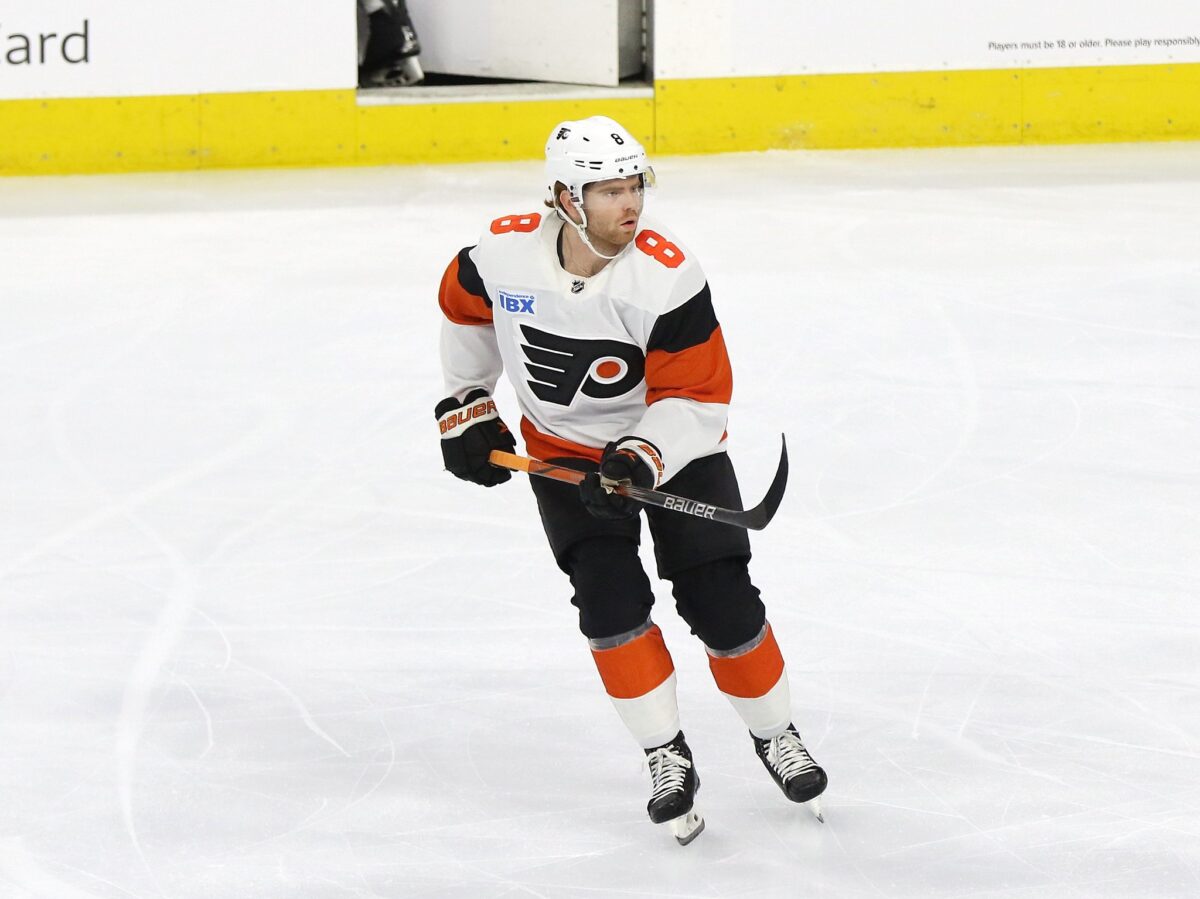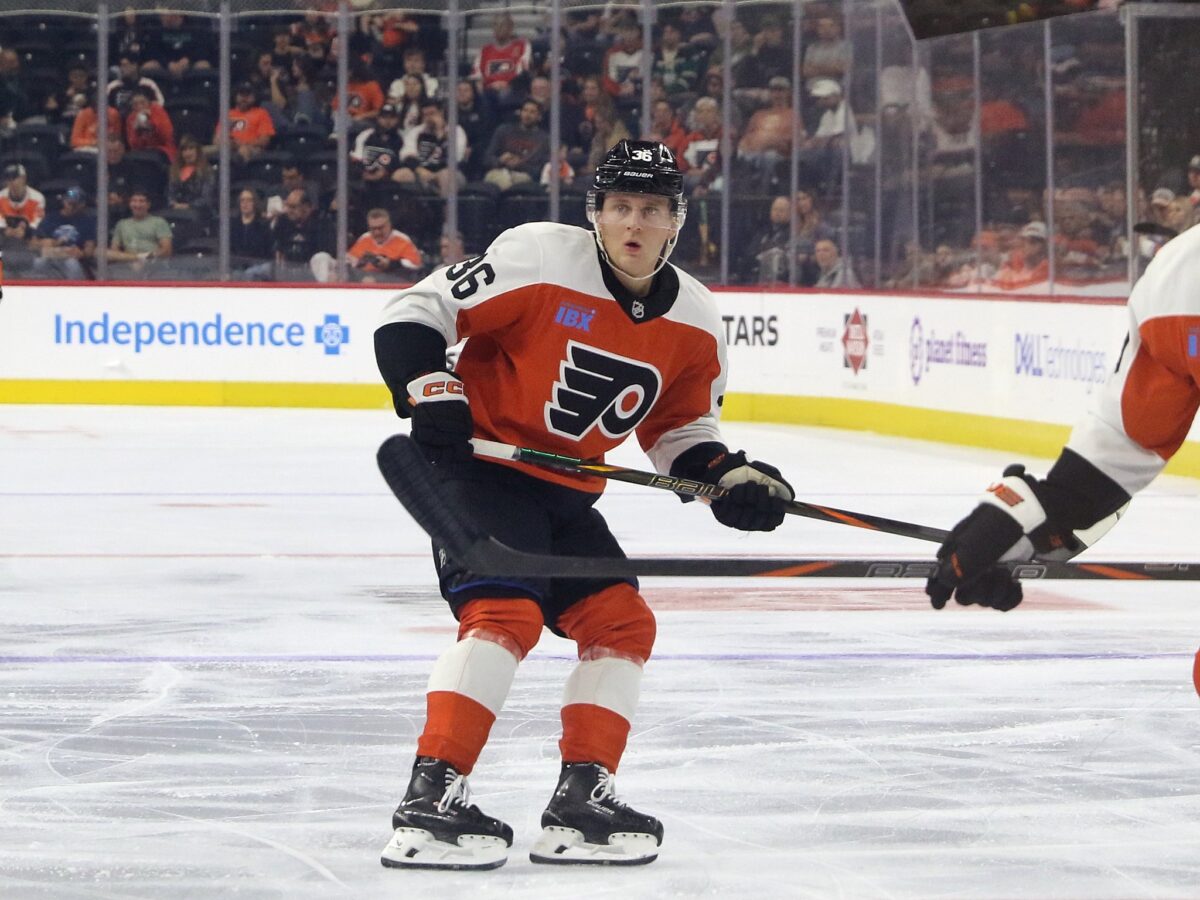The Philadelphia Flyers mostly have their headlines occupied by star rookie Matvei Michkov, which has distracted from the others excelling on the roster. The Flyers possess three young defensemen who inspire that, someday, the defense could be a top-of-the-line unit. Who are those players?
Cam York
In a contract year, it’s not too surprising that Cam York got off to a good start in 2024-25. Before the 23-year-old was placed on injured reserve on Oct. 26, he was playing at a high level, showing he has the upside to be an essential piece to the defense for a long time. His possession metrics (albeit in a small seven-game sample size) have been terrific.
Related: 3 Reasons the Flyers Have Floundered in 2024-25
As outlined in the related piece above, the Flyers have not been good at even strength. They’re not generating shot attempts, shots on goal, or scoring chances. While this is partially because they aren’t doing much with the puck when they have it, the Orange and Black have also not had the puck enough. York is the exception.

At even strength, the Flyers have spent just 39.5 percent of their ice time in the offensive zone to 41.7 percent in the defensive zone per NHL Edge. Since they lack offensive firepower, the Flyers aren’t doing much with the below-average offensive zone time they do get. On the other hand, the more talented clubs take advantage. The result, unsurprisingly, is a hockey team with a losing record (6-8-2).
Then, there’s York. With 42.2 percent of his even-strength ice time spent in the offensive zone and 39.0 percent of it spent in the defensive zone, he has been able to out-chance his opponents (team-leading 58.3 expected goals percentage) unlike most of his teammates. A defenseman who plays against top competition being able to tilt the ice in a completely different direction is indicative of a pretty special player. He’s showing more offensive upside, too, which is a huge step in the right direction.
Considering his very low on-ice shooting and save percentages, he should have better basic statistics like points and plus/minus when he returns to health. For the past three seasons, he has proven he can be a top-pairing player. If he can continue his 2024-25 excellence, which has been quite a step ahead of where he was in 2023-24 where he was also on the first pair, that could firmly put him in star defensemen talks.
Jamie Drysdale
On the flip side, things haven’t exactly gone smoothly for Jamie Drysdale. Since he was acquired by the Orange and Black for top prospect Cutter Gauthier on Jan. 8, the 22-year-old defender’s numbers have been some of the worst in the NHL. But, there’s context needed here. Brighter days are ahead.
Drysdale has lost a lot of time to injuries. A torn labrum slashed 74 games out of his 2022-23 campaign, and he could only suit up for 34 contests last season. In the games he was able to dress for, he was battling a sports hernia that limited his upside. That, combined with being introduced to a new system, sunk his numbers. It’s not rocket science.
In the present, he is back on injured reserve after 15 mostly underwhelming matches. There are a few things to note here, though.
For one, players typically need more than just a few months to recover from an injury-riddled campaign. Plus, Drysdale’s still learning a lot of things, and that’ll take time—maybe another year or two. The hope is that, fairly quickly, he’ll stop being caved in the defensive zone so often (43.1 percent of his even-strength ice time has been spent there), but he might not grade out as a great top-four defender for a bit. Be prepared to wait.
As for some criticisms of his game, Drysdale possesses a lot of talent but seems hesitant to use it. For example, he’ll oftentimes try stretch passes instead of skating the puck up the ice when he has room in the defensive zone. One of his biggest assets is his skating, yet he seems reluctant to use it to its fullest potential. Based on my eye test, this has been one of the biggest reasons his numbers are as poor as they are. His long-range (and unnecessary) pass attempts sometimes give possession over to the other team, leading to long shifts and numerous scoring chances allowed. Again, he’s still figuring things out, but he’s been a net negative because transitioning from the defensive zone to a threatening offensive attack has been non-existent when he’s on the ice.
To be fair, we can probably blame the injuries on this. Drysdale has lost a lot of hockey and likely isn’t operating at what his body is fully capable of—he may not trust himself to dart up the ice when a pass is less risky and a fine alternative. But for him to be a high-level player, he needs to make high-level plays. While this change won’t happen overnight, the hope is that some of those signs can show more consistently as this campaign moves along. He has a ton of upside and could be a top-pairing defenseman someday. This is possible if he can play with more confidence and learn some things along the way.
Emil Andrae
In light of York’s injury, Emil Andrae entered the lineup and has taken off for the Flyers. Playing 25:40 of ice time against the San Jose Sharks last night (Nov. 11), it’s hard to see a world where the 22-year-old touches American Hockey League (AHL) ice anytime soon. In fact, he may never play in the AHL again.
Related: Flyers’ Michkov, Andrae Take Advantage Of Opportunities Against Sharks
York and Drysdale are both below average on the height and weight scale (neither are above 6-foot-0 or 195 pounds), but Andrae takes this to a new level. At 5-foot-9 and 189 pounds, he is one of the smallest defensemen in the sport. However, he can hang with the big guys.
Of the 200 defensemen who have played at least 100 minutes at even strength, he is second in relative expected goals percentage (xGF% Rel; 18.2). Compared to the rest of his team, he’s one of the biggest outliers in the NHL in his share of scoring chances. The Flyers have been outplayed for most of the season, but not Andrae. The dynamic shifts when he’s on the ice.

Do you want to know the best part about this? The only player ahead of him is York. If we just look at relative expected goals per 60 (xGF/60 Rel, which disregards the defensive portion of the statistic above), they’re both among some great athletes. The top 10 leaders in xGF/60 Rel:
- Dougie Hamilton (1.85)
- Alex Pietrangelo (1.66)
- Marcus Pettersson (1.49)
- Brenden Dillon (1.44)
- Quinn Hughes (1.28)
- Adam Fox (1.27)
- Cam York (1.25)
- Emil Andrae (1.25)
- Rasmus Dahlin (1.15)
- Miro Heiskanen (1.10)
The offensive impact is being exaggerated, and perhaps by a decent amount. This is especially true with the underwhelming conversion rate on expected goals for Andrae in particular (one goal for every 2.21 expected goals). You get the point, though. He has been a force, and really, it’s not all that shocking. Andrae has taken big steps since he was eliminated in the 2024 AHL Playoffs with the Lehigh Valley Phantoms—he’s a new player. He might be a minute muncher for years to come.
A trio of young defensemen are especially inspiring for the Flyers’ future. Two of them (York and Andrae) are playing tremendous hockey, while the other (Drysdale) could start to shine when he is more comfortable. The future of the defense is beaming with hope.
Stats courtesy of Natural Stat Trick
